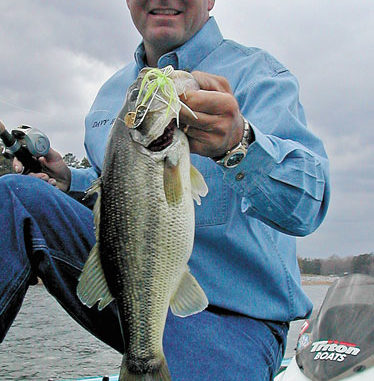
Bass fishermen make it through the summer, through the 85-degree surface temperatures and 95-degree, breezeless days, just waiting for the fall to arrive.
It arrives this month, but it will be a while before most of us are happy, because for the most part, September is one of the toughest months. For bass fishermen in South Carolina, it’s the month we dread the most. It’s hard to say that, but it’s true.
The problem is, fish are in transition. It’s still summer in early September, but the shad are starting to migrate back into the creeks like it’s fall. When it starts depends on the kind of summer we’ve had or how soon we start to have some cool mornings. It will start cooling off a little bit because the days are getting shorter, but the weather will have something to do with it.
The shad are moving, so I’m going to concentrate on the mouth of creeks to halfway back. Later on in the month and toward the beginning of October, they’ll get farther back in the creeks. In South Carolina, we’re blessed with great populations of shad. The bass follow them, and the big problem is, they’re suspended. They’re all around the big schools of shad, and they’re not relating to any kind of cover, so you can’t target them the way you do most of the year.
You have to convince yourself that a good catch in September might not be a good catch any other time. Ten pounds a day in September might really be good in a tournament; 10 pounds a day in March — you don’t even want to walk that bag to the scales.
My first plan of attack is topwater baits. I like to fish big, walking baits likes Spooks or popping baits like a Zell Pop. What you’re trying to do is call a fish up. Fish are predators, and they’re competitive. They’re down there around 10 million shad, and you have to do something to get a bite. You have to get their attention, and a noisy bait at the surface. They might think it’s another bass up there trying to feed, and they want to get up there and maybe grab a meal. You’re bringing out their competitive nature. I’ll also throw a weightless Senko in and let it fall on a slack line, because maybe there’s a fish down there who thinks it’s a dying shad sinking that’s an easy meal and you get a bite.
The other thing I try is to look for any kind of cover or structure that’s close to big schools of bait, maybe a brushpile or standing timber or a log — any kind of thing that a bass might position on for a few minutes. At this time of the year, bass are moving all the time, so you can find pieces of cover like that and just move between them, fishing them multiple times. If you don’t catch one on a brushpile, you might go back in an hour and a bass might have moved up on it to rest and feed. When they get on that kind of cover, that’s when you can get a reaction bite with something like a spinnerbait or a crankbait. The other thing I look for are good drops along the creek channel, because the shad are roaming up and down those creeks, and channel drops are places where they’ll stop — and where bass will stop to feed.
One thing I’ve learned over the years of fishing lakes like Murray and Hartwell and Wateree and Clarks Hill is that there are absolutely some creeks that will hold more shad in the fall. If you don’t know a lake, it’s a trial-and-error deal; you just run up and down the creeks, looking for signs of shad activity at the surface or on your depthfinder. If I don’t see bait, I won’t stay in that creek.
The strange thing is, there’s nothing really in common among those creeks, as much as I can tell. When we had the big drawdowns at Murray and Hartwell and Clarks Hill in recent years, I went out and looked, and the places I’ve always found a lot of shad and caught fish, and they didn’t have anything in common; there wasn’t one primary reason the shad were there and the bass were there. Some of the places looked fabulous, just what you’d expect, but some where just big, open flats that didn’t look like anything. There was no one factor I could put my finger on.
So, when your Labor Day Weekend dove hunt is over, and you get back on the water, don’t expect to bag 15 or 18 pounds every time out. Don’t expect as much, and what you wind up setting for might wind up being pretty good — until things get better and easier.
Davy Hite, a 44-year-old native of Saluda who lives in Ninety Six, was BASS Angler of the Year in 1997 and 2002, and he has won the 1999 Bassmasters Classic and the 1998 FLW Tour Championship. He is sponsored by Advance Land & Timber, Triton boats, Evinrude outboards, All-Star rods, Pfleuger reels, Berkley Trilene, Yamamoto Baits, Owner hooks, Humminbird depthfinders and Solar Bat sunglasses.




Be the first to comment